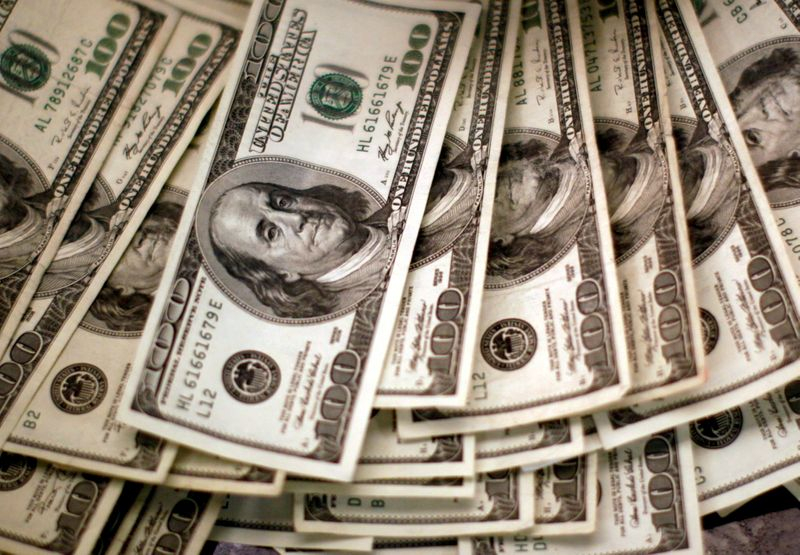Dollar firm as traders brace for U.S. inflation data By Reuters

By Tom Westbrook
SINGAPORE (Reuters) – The U.S. dollar held near multi-month highs on Friday as investors warily awaited U.S. inflation data, while the pound nursed modest losses after Bank of England (BoE) policymakers leaned away from flagging rate rises.
Early Asia trade was steady, with the euro pinned below its 200-day moving average at $1.1930 and the yen just short of a 15-month low at 110.955 per dollar.
The dollar vaulted to its highest levels since March against the euro last week – and to its highest since March 2020 on the yen – after the U.S. Federal Reserve surprised markets by projecting interest rate rises sooner than expected in 2023.
Subsequent rhetoric from Fed chair Jerome Powell seems to have calmed nerves in bond and stock markets about hikes any time soon, but the dollar has held its gains and traders are wary of further rises if inflation is hotter than forecast.
Economists polled by Reuters expect core personal consumption expenditures index to post year-on-year gains of 3.4%, a rise even faster than the nearly three-decade high pace of 3.1% recorded last month. The data is due at 1230 GMT.
“The dollar can jump if inflation surprises to the upside,” said Joe Capurso, head of international economics at the Commonwealth Bank of Australia in Sydney. “Upside inflation surprises have been the trend in the U.S. recently,” he said.
The stronger dollar has kept other majors in check through the week, even against currencies where rate rises are likely to land sooner than in the United States.
The New Zealand dollar has crept back above its 200-day moving average to $0.7063, but it remains well shy of February highs above 74 cents. In Australia, despite booming terms of trade, the Aussie held at $0.7584. [AUD/]
“A more balanced dollar outlook prevails after the Fed’s decisive policy shift,” Westpac strategist Sean Callow said.
“The Australian dollar’s strong support from commodity prices produces fair value estimates in the mid-0.80s,” he said.
“Yet recent price action has been in the mid-0.70s. With risk appetite looking resilient, any narrowing in this gap probably depends on how far the (Fed)-inspired U.S. dollar recovery can extend.”
The U.S. dollar index was steady at 91.833, off a week-ago high of 92.408 but clear of troughs below 90 that it had plumbed in May.
Sterling had started to move away from its post-Fed lows, but was the weakest G10 currency overnight and fell 0.3% after the BoE failed to provide any hint it was in a hurry to hike rates and warned against “premature tightening”.
“Some in the market obviously positioned for a less dovish or a hawkish tilt,” said Tapas Strickland, director of economics and markets at National Australia Bank.
In emerging markets, the Mexican peso surged to a two-week high following a surprise benchmark interest rate hike.
Bitcoin was steady at $34,380 and headed for a small weekly loss, as it has recovered most of a plunge below $30,000.
Currency bid prices at 0128 GMT
Description RIC Last U.S. Close Pct Change YTD Pct High Bid Low Bid
Previous Change
Session
Euro/Dollar
$1.1940 $1.1931 +0.08% -2.28% +1.1940 +1.1928
Dollar/Yen
110.8900 110.8300 +0.08% +7.38% +110.9800 +110.9150
Euro/Yen
132.39 132.27 +0.09% +4.31% +132.4200 +132.2600
Dollar/Swiss
0.9173 0.9180 -0.04% +3.72% +0.9182 +0.9176
Sterling/Dollar
1.3925 1.3922 +0.00% +1.90% +1.3925 +1.3915
Dollar/Canadian
1.2318 1.2319 +0.03% -3.23% +1.2329 +1.2320
Aussie/Dollar
0.7589 0.7583 +0.08% -1.35% +0.7590 +0.7580
NZ
Dollar/Dollar 0.7070 0.7062 +0.09% -1.57% +0.7071 +0.7060

